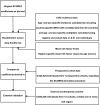Risk prediction of cardiovascular disease in the Asia-Pacific region: the SCORE2 Asia-Pacific model
- PMID: 39217477
- PMCID: PMC11842970
- DOI: 10.1093/eurheartj/ehae609
Risk prediction of cardiovascular disease in the Asia-Pacific region: the SCORE2 Asia-Pacific model
Abstract
Background and aims: To improve upon the estimation of 10-year cardiovascular disease (CVD) event risk for individuals without prior CVD or diabetes mellitus in the Asia-Pacific region by systematic recalibration of the SCORE2 risk algorithm.
Methods: The sex-specific and competing risk-adjusted SCORE2 algorithms were systematically recalibrated to reflect CVD incidence observed in four Asia-Pacific risk regions, defined according to country-level World Health Organization age- and sex-standardized CVD mortality rates. Using the same approach as applied for the original SCORE2 models, recalibration to each risk region was completed using expected CVD incidence and risk factor distributions from each region.
Results: Risk region-specific CVD incidence was estimated using CVD mortality and incidence data on 8 405 574 individuals (556 421 CVD events). For external validation, data from 9 560 266 individuals without previous CVD or diabetes were analysed in 13 prospective studies from 12 countries (350 550 incident CVD events). The pooled C-index of the SCORE2 Asia-Pacific algorithms in the external validation datasets was .710 [95% confidence interval (CI) .677-.744]. Cohort-specific C-indices ranged from .605 (95% CI .597-.613) to .840 (95% CI .771-.909). Estimated CVD risk varied several-fold across Asia-Pacific risk regions. For example, the estimated 10-year CVD risk for a 50-year-old non-smoker, with a systolic blood pressure of 140 mmHg, total cholesterol of 5.5 mmol/L, and high-density lipoprotein cholesterol of 1.3 mmol/L, ranged from 7% for men in low-risk countries to 14% for men in very-high-risk countries, and from 3% for women in low-risk countries to 13% for women in very-high-risk countries.
Conclusions: The SCORE2 Asia-Pacific algorithms have been calibrated to estimate 10-year risk of CVD for apparently healthy people in Asia and Oceania, thereby enhancing the identification of individuals at higher risk of developing CVD across the Asia-Pacific region.
Keywords: Cardiovascular disease; Primary prevention; Risk prediction; Ten-year CVD risk.
This article has been co-published with permission in the European Heart Journal, the Journal of Asian Pacific Society of Cardiology, and the ASEAN Heart Journal. © 2024 the European Society of Cardiology, the Asian Pacific Society of Cardiology, and the ASEAN (Association of South-East Asian Nations) Federation of Cardiology. The articles are identical except for minor stylistic and spelling differences in keeping with each journal's style. Either citation can be used when citing this article.
Figures









References
-
- Roth GA, Abate D, Abate KH, Abay SM, Abbafati C, Abbasi N, et al. Global, regional, and national age-sex-specific mortality for 282 causes of death in 195 countries and territories, 1980–2017: a systematic analysis for the Global Burden of Disease Study 2017. Lancet Rheumatol 2018;392:1736–88. 10.1016/S0140-6736(18)32203-7 - DOI - PMC - PubMed
Publication types
MeSH terms
Grants and funding
- Department of Health and Community Services-Northern Territory
- the Office of the Higher Education Commission
- AstraZeneca
- the Philippine Society of Hypertension
- Marian & FH Flack Trust
- Novartis Pharmaceuticals
- Jack Brockhoff Foundation
- Novo Nordisk Pharmaceuticals
- Pratt Foundation
- Diabetes Australia
- Department of Health-Western Australia
- Department of Health-South Australia
- Merck Sharp & Dohme
- Pfizer Pty Ltd
- Eli Lilly Australia
- National University of Singapore and National University Health System, Singapore
- RG/13/13/30194/BHF_/British Heart Foundation/United Kingdom
- Australian Stroke and Heart Research Accelerator Centre Targeted Translation Research Accelerator
- the Victorian Government's OIS Program
- the Faculty of Medicine Ramathibodi Hospital, Mahidol University
- the Philippine Heart Association
- Sanofi Aventis
- National Health and Medical Research Council Investigator Grants
- Janssen-Cilag
- Abbott Australasia Pty Ltd
- Diabetes Philippines
- City Health Centre-Diabetes Service-Canberra
- National Medical Research Council (NMRC)
- Estate of the Late Edward Wilson
- the project for Higher Education Research Promotion and National Research University Development
- Roche Diagnostics Australia
- MR/L003120/1/MRC_/Medical Research Council/United Kingdom
- Diabetes Australia Northern Territory
- Department of Health and Human Services-Tasmania
- 03-006-2023-0095/Dutch Heart Foundation
- Kidney Health Australia
- 233200/National Health and Medical Research Council
- Menzies Research Institute
- 2020YFC2003503/National Key Research and Development Program of China
- the Thailand Research Fund
- the Philippine Lipid and Atherosclerosis Society
- Royal Prince Alfred Hospital, Sydney
- LRI Therapharma
- Amgen Australia
- 2022R1F1A1066181/Korea Ministry of Science and ICT
- Bristol-Myers Squibb
- 82373662/National Natural Science Foundation of China (NSFC)
- GlaxoSmithKline
- Department of Human Services-Victoria
- sanofisynthelabo
- Queensland Health
- Department of Health-New South Wales
- the National Research Council of Thailand
- the Biomedical Research Council (BMRC) of Singapore
- Singapore Ministry of Health (Population Health Metrics Population Health Metrics and Analytics PHMA)
- the Electricity Generating Authority of Thailand
- the Philippine Council for Health Research and Development
- Alphapharm Pty Ltd
- Australian Government Department of Health and Ageing
LinkOut - more resources
Full Text Sources

